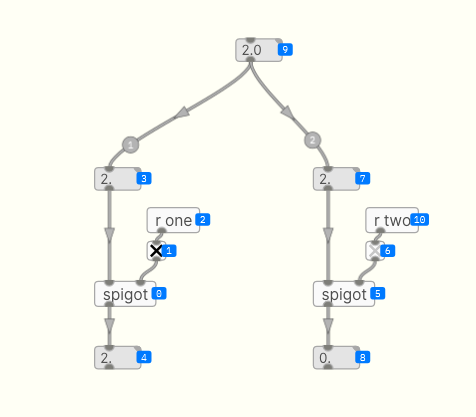-
ytt
posted in technical issues • read moreThank you for the clarification.
I was testing hv.freqshift with sine waves and couldn't notice the difference but it was evident when used with adc~. -
ytt
posted in technical issues • read moreHello!
Is it possible to use the hv.freqshift~ as a pitch shifter maintaining the same ratio for each interval irrespectively of the incoming frequency? For example, use it to transpose a specific interval.
Thanks -
ytt
posted in technical issues • read moreThanks a lot @fishcrystals
That's exactly what I was looking for and it works perfectly.
It's great that I can choose to recall the values only when the knob reaches its initial position or have them update immediately as soon as I adjust the knob, just have to remove the top portion of your patch.
It's quite enjoyable to come up with creative solutions to overcome the limitations of the pods.
Hopefully, midi functionality will be quickly integrated into the pd2dsy. -
ytt
posted in technical issues • read moreThanks a lot for your feedback.
That's exactly what I'm looking for.
The goal is to install this patch on the electro-smith daisy pod. Unfortunately, not all pd elements are supported, specifically ones related to lists and Exp.
Is there a different approach to achieve the same outcome?The tricky part is that the knob/potentiometer keeps sending its current value. If I could make it act more like pd's slider or number box, I think it might work.
My understanding of pd is pretty basic, so I really appreciate your help.
Unsupported_vanilla_objects:
https://github.com/CorvusPrudens/hvcc/blob/develop/docs/10.unsupported_vanilla_objects.md -
ytt
posted in technical issues • read moreHello .
I'm developing a multi-effects patch with only two knobs and two switches for control. I'm using select and spigot to navigate and tweak through the different parametersI'm seeking guidance on how to ensure that parameter values are updated only when the knobs are adjusted.
Whenever I switch effects, the values/numbers from the previous effect transition to the new one, causing unintended fluctuations. I've attempted to work with float and change objects, but I've encountered repetitive operations that haven't effectively addressed the problem.
Thank you

-
ytt
posted in extra~ • read moreThanks a lot for the replies and for sharing the project.
I had given up from using the pd-lib-builder because i feel i don´t have yet the basic notions to follow the instructions , even though they were very simple. i guess i need to go back to the basics. i think i don´t even have Pd-Lib-Builder well installed.but well, i truly appreciate your answers and helmholtz~ is working fine.
-
ytt
posted in extra~ • read moreHi, i'm relatively new to Pd but I have been slowly making my way trough tutorials and information given trough the forums. I'm interested in pitch detection functions and i found the helmholtz~ object by Katjav.
i've been trying to compile the file using Msys2 , with no success , I don´t have no experience working with C + but after installing Msys2 and following the instructions I still canot have it working mainly because i'm not sure what does each line really means, I imagine it's really basic stuff but i'm lost .
Does anyone have a built up version for windows 64bit or can help me with a more precise step by step instructions?thanks a lot
here are the instructions
Open the Makefile in helmholtz~/src and edit the target suffix to match your system: (in which program am i suppose to pen the file?)
pd_darwin for OSX
pd_win for Windows with MinGW
pd_linux for LinuxFor 64 bit systems, flag -fPIC may be added to compiler flags. /how to I apply the flag?)
In terminal, cd to directory helmholtz~/src and type 'make'. The binary is copied to directory helmholtz~/ and you can use it from there or copy it to a directory in Pd's path.
